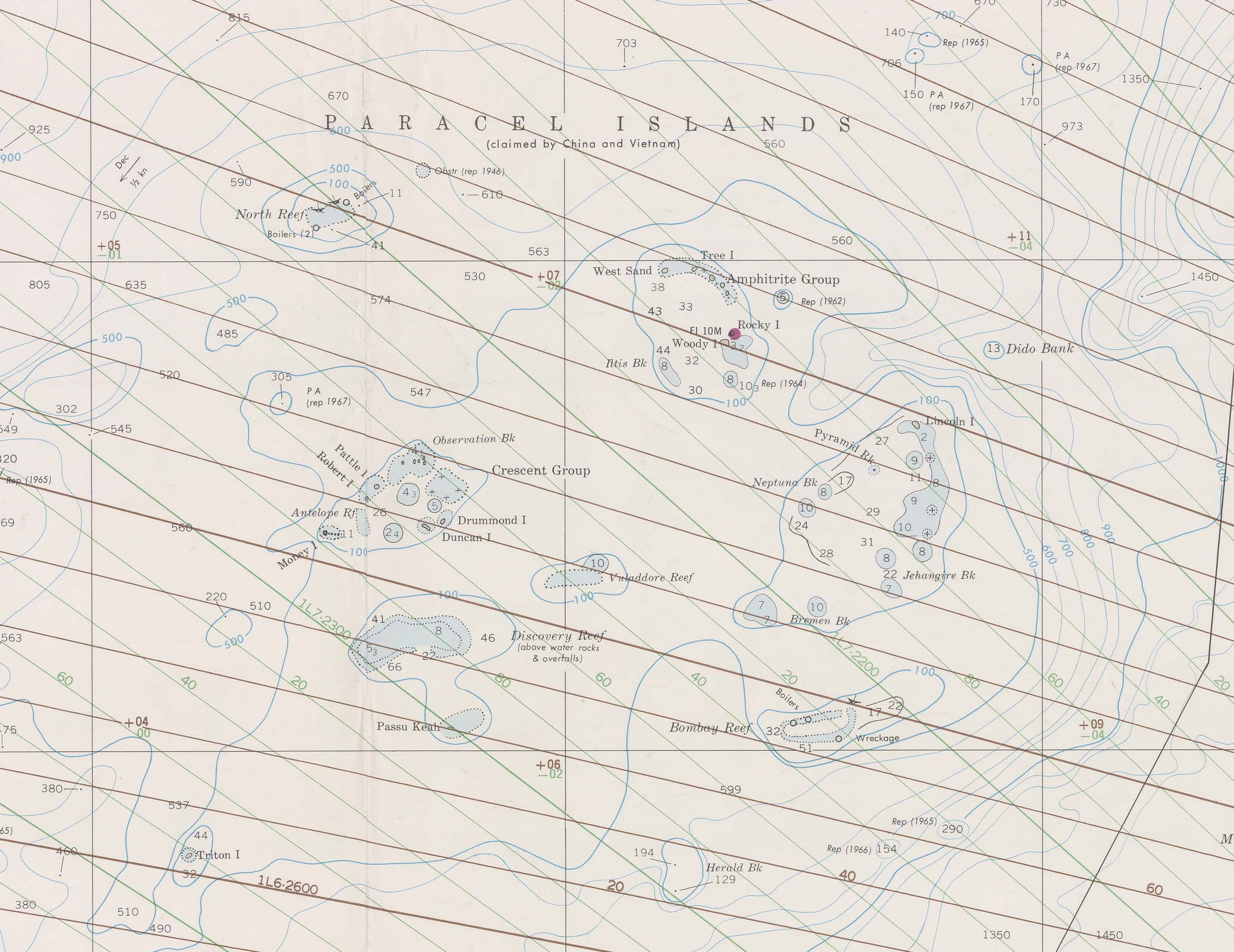
Nautical chart of the Paracel Islands in the South China Sea, with Woody Island highlighted in yellow.
“China has opened a hardware store on a disputed South China Sea island, according to the local government, as Beijing ramps up efforts to expand civilian facilities and cement claims in the strategically important waterway.”
Building civilian infrastructure and populating the newly built islands of the South China Sea is part of a cycle of building, populating, and defending that population and infrastructure that China is growing throughout the disputed islands. A recent article in Hong Kong-based South China Morning Post (SCMP) focused on a strategic but otherwise mundane-seeming event—the opening of Xinyi Hardware Store on Woody Island in the Paracel Islands in the South China Sea.[i] According to the SCMP article, the opening of the hardware store reflects the growing number of civilians and civilian enterprises China is moving to its newly created territories in the South China Sea. The article notes that the hardware store serves both Chinese military and civilians in Shansha City, which was established in 2012 to be the administrative center of Chinese efforts to control the islands and features of the South China Sea. Shansha City is also focal point of Chinese naval and coast guard assets in the region. Today Shansha City boasts a population of more than 2,300 civilians, an undisclosed number of military personnel, a civil-military airport, a 5,000-ton wharf, a post office, banks, schools, library, parks, hospitals, and power plant—all the trappings of a modern city.[ii]
The move has also encouraged other nations with claims in the South China Sea to follow suit. Vietnam is building up its presence in the Paracel Islands and has increased its efforts to solidify its position on Barque Canada Reef, a narrow, 18-mile atoll on the southern end of the Spratlys. Vietnam has doubled the size of the Barque Canada Reef to 492 acres since November 2023.[iii] Chinese and Vietnamese efforts to populate the islands within their control do not change the operational environment – they create the operational environment – and should be recognized as tactics used to gain legitimacy for claims to control parts of the South China Sea.
Sources:
“South China Sea: Beijing opens hardware store on disputed Woody Island,” South China Morning Post (Hong Kong-based English language media outlet), 3 August 2024. https://www.scmp.com/news/china/diplomacy/article/3273082/south-china-sea-beijing-opens-hardware-store-disputed-woody-island
China has opened a hardware store on a disputed South China Sea island, according to the local government, as Beijing ramps up efforts to expand civilian facilities and cement claims in the strategically important waterway.
Covering an area of about 100 square metres (1,076 square feet), the Xinyi Hardware Store is located on Woody Island in the Paracel Islands, a contested archipelago known in Chinese as the Xisha Islands and in Vietnamese as the Hoang Sa Islands.
The store, situated next to the cargo terminal of the Sansha Yongxing Airport, opened for business on Thursday, according to the government of Sansha city, which oversees the Paracels as well as the Macclesfield Bank and the Spratly Islands – another disputed archipelago known as the Nansha Islands in Chinese.
Located about 300km (186 miles) from the southern Chinese island province of Hainan, Woody Island – known as Yongxing Island in China – is the largest outcrop among the 30 or so islands that make up the Paracels. The archipelago is controlled by Beijing but also claimed by Taipei and Hanoi.To assert its claims to the resource-rich waters, Beijing in 2012 announced the establishment of Sansha city on Woody Island to administer the disputed South China Sea islands and features.
Notes:
[i] Like most of the features of the South China Sea, the Paracel Islands are jointly claimed. The Philippines, Taiwan, Vietnam and China each claims jurisdiction and hold on to shoals and islands under their respective control. All nations with a claim are building out infrastructure to cement control over territory held.
[ii] The opening of the hardware store on Shansha city is the most recent in a number of media publicized opennings. In April 2023 China opened the Kuanzhai Xiangzi hotpot restaurant in Shansha City on Woody Island. See: “South China Sea: Beijing opens hotpot restaurant on Woody Island in disputed Paracels chain,” South China Morning Post, 30 April 2023. https://www.scmp.com/news/china/diplomacy/article/3218912/south-china-sea-beijing-opens-hotpot-restaurant-woody-island-disputed-paracels-chain?module=inline&pgtype=article
[iii] For a recent U.S. media perspective on Vietnam’s herculean effort to dredge the sea floor, fill in land, fortify barriers and erect new structures on Barque Canada Reef, see: “Vietnam accelerates island building to challenge China’s maritime claims,” The Washington Post, 9 August 2024. https://www.washingtonpost.com/world/interactive/2024/vietnam-south-china-sea-islands-growth/
Image Information:
Image: Nautical chart of the Paracel Islands in the South China Sea, with Woody Island highlighted in yellow.
Source: https://en.wikipedia.org/wiki/Paracel_Islands – /media/File:Asia_-_South_China_Sea_-_Mui_Da_Nang_to_Shen-Ch’uan_Chiang_including_Hai-Nan_Tao_and_Paracel_Islands_(Paracel_Islands_cropped).jpg
Attribution: Public Domain, yellow highlight by author
